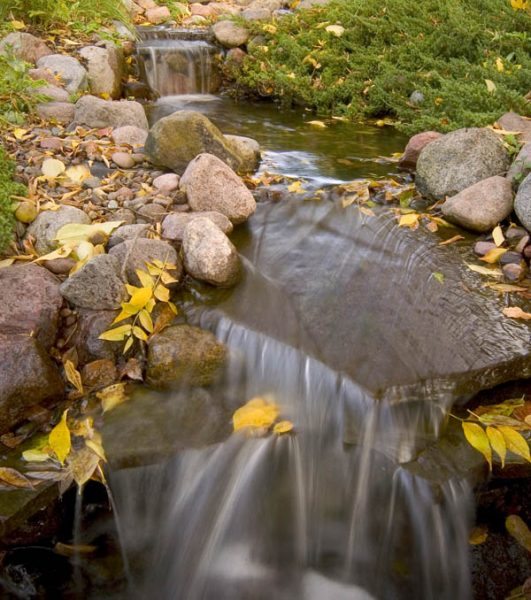Fall is fast approaching which means it is the time to prepare to get your pond ready for the Winter season. Here’s a breakdown of what you should be doing to prepare your pond, fish, and plants for a healthy successful Winter.
All summer long, you’ve enjoyed the tranquility of the water garden’s beautiful foliage, sounds of cascading water and colorful fish eagerly awaiting a handful of food. The water garden didn’t get that way by itself. You add the right kinds of plants and fish to create a balanced ecosystem. The water gardens we create look beautiful and sustain life because we work with Mother Nature. During the winter months, despite all outward appearances, the pond is active even when the water is cold or even frozen.
Remove leaves and debris
As the leaves start to turn color, putting a pond net over your water feature before they start falling from trees is the easiest way to contain and manage leaf control. Use of a net will also prevent the frequent overburdening of debris in your skimmer box. Once all the leaves have fallen, simply roll up the net, discard the leaves, and put the net away until the next time it’s needed.
If you didn’t install netting, you’ll probably have a build up of leaves and debris that need to be removed before Winter. A long-handled pond net makes an easy job of scooping the debris from the bottom of the pond. If you leave the debris on the bottom of the pond, you’ll be creating a bigger mess to face in the spring. This will also prevent the frequent overburdening of debris in your skimmer box. It is imperative that the debris not be allowed to sit in your pond during the winter months. A build-up of leaves and other organic matter can cause an imbalance, reducing oxygen to dangerously low levels and releasing poisonous hydrogen sulfide putting your fish and frogs health in jeopardy.
***Interested in Fall/Winter Pond Services?! Click Sign Up below to learn more or click here to order pond supplies to do-it-yourself click Shop Now: or
or
Add cold water bacteria
We recommend adding beneficial bacteria, such as Aquascape Cold Water Beneficial Bacteria to help keep pond water clean and clear. Cold Water Beneficial Bacteria contains healthy concentrated strains of beneficial bacteria designed to work in temperatures lower than 50 degrees. This product contains healthy strains of beneficial bacteria that digest dead algae and sludge that accumulate in filters and at the bottom of the pond. Regular monthly use of Aquascape Cold Water Beneficial Bacteria will help maintain water quality and clarity, as well as dramatically reduce spring maintenance by digesting debris that may accumulate over the winter months. Aquascape bacteria products are completely safe and help keep your pond clean.
Trim dead or dying water plant foliage
Trimming the dead foliage will help remove excessive organic debris that would otherwise decompose in the water.good idea to cut back hardy waterlilies just above the base of the plant and cut back marginal plants just above the surface.
What should I do with my fish?
Water gardens with depths of 24″ or greater can leave their fish in their pond all winter long successfully providing they’ve followed the guidelines set forth previously in this article. Hopefully you have been feeding your fish well with a high protein food this summer to allow them to build up a reserve of fat to help them through the winter. Now is a good time to get some Cold Weather Fish Food. Once the water temperature reaches the low sixties you should decrease the amount of food given and feed one to three times per week. At this time provide a food with a protein content of 25 to 32 percent. A wheat germ based food is good at this time as it is easily digested. Once the temperature drops below 50 degrees stop feeding altogether until spring when the water temperature is consistently above that same level. Good idea to have a Pond Thermometer.
There are a few other considerations to over wintering your fish in the pond. The first is that as organics decompose in the pond they can produce toxic gases that could be trapped in the pond if it is covered by ice for more than a few days. It is important to keep a small area ice free with the Aquaspace De-Icer. This heater operates at only 300 watts compared to some other products that operate at 1000 or even 1500 watt$! Plus this is the absolute most reliable heater on the market. It may be a little more expensive then the others but it is well worth the investment. The last thing you want is your pond heater/de-icer to fail in the single digits and be trying to figure out a quick way to save your fish! Another option to keeping a small hole in the ice is to operate an air pump with an air diffuser to assist with keeping a hole open in the ice. The constant motion of air bubbles through the water will prevent the ice from forming. This works best with a heavy duty aerator such as The Aquascape Aerators. Becareful as this method is not as reliable as the heater and/or AquaForce Pump Aeration de-icer.
If you leave your pond running
Operating your pond and waterfalls during the winter will provide beautiful ice formations for you to enjoy throughout the frosty season. Keep in mind, there will be a bit of maintenance required this time of year, such as topping off the pond due to evaporation. Also, you’ll need to make sure ice formations don’t create dams that can cause unnecessary water loss over the edge of the stream.
If you shut down the pond
Many homeowners in northern climes choose to shut down the pond for the winter months. If you choose this option, remember to:
- Remove the pump from your pond and store it in a warm place like the garage or the basement. Protection from the cold lengthens the life of your pump.
- Drain the water out of the plumbing. This prevents standing water from freezing and expanding, potentially cracking the pipes that connect your filtration system.
- Remove and clean the filter media and spray them thoroughly with a garden hose. Store them in the garage or the basement along with the pump.
- Oxygenate the water by placing a small re-circulating pump, such as the AquaForce® on the top shelf of your pond. Oxygenating the water is not only for the sake of your fish, but it also helps keep a hole open in the ice when the surface of your pond starts freezing. This hole allows harmful gasses to escape, and oxygen to get in.
- If it gets really cold where you live, you may consider adding the Aquascape DeIcer. At extremely low temperatures, the oxygenation of the water may not be sufficient to keep a hole open in the ice.
- That’s where the AquaDeicer saves the day. It compliments the bubbler and, together, they’ll keep most any pond open.
By performing these tasks you will ensure that your plants, fish, and pond will live through the winter and thrive the next spring!
Happy Ponding!!!
***Interested in Fall/Winter Pond Services or Supplies?! Click below to learn more:
Fall Pond Maintenance
Pond Supplies for Do-It-Yourselfers
Questions Call/Text to 585-337-2468









